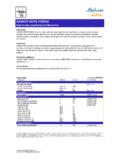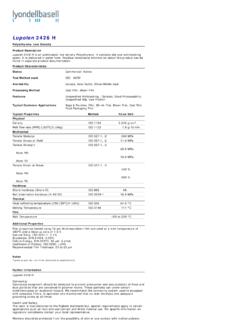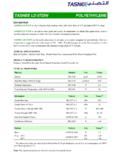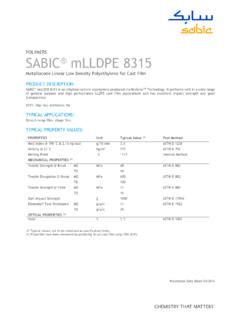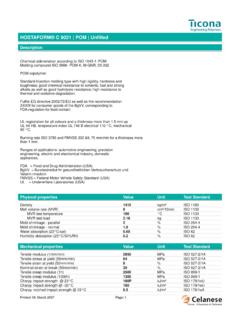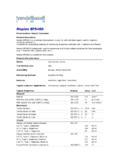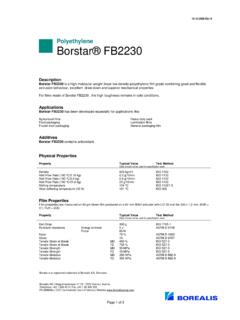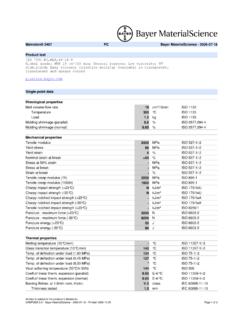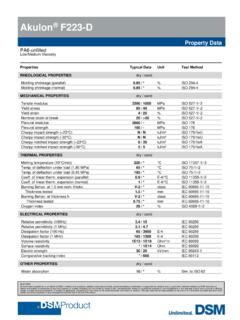Transcription of MAGNUM 3404 - b2bPolymers.com
1 Product InformationMAGNUM3404 Natural Plus ABS ResinsProperties(1)Test MethodValueISOASTMDINP hysical PropertiesDensity, kg/m31183BD-792-B53479-B1050 Bulk density, kg/m360D-189553468650 Melt flow rate (230 kg), g/10 flow rate (220 C/10 kg), g/10 PropertiesVicat softening point (50 C/h, 5 kg), C306BD-1525-A53460100 Vicat softening point (120 C/h, 1 kg), C306AD-1525-B110 HDT, annealed (120 C/hr, MPa), C75/AD-64853461-A101 Mechanical PropertiesCharpy notched, kJ/m223 C179/2C53453130 C179/2C5345311 20 C179/2C5345310 40 C179/2C534538 Charpy notched, kJ/m223 C179 30 C179/1eA534539 Charpy unnotched, kJ/m223 C179/1eU53453no break 30 C179/1eU53453no breakIzod notched, kJ/m223 C180/1A22 Tensile yield, 100 mm/min.
2 , MPaDIS527/DD-638-M53455-6-346 Tensile elongation, %DIS527/DD-638-M53455-6-340 Tensile modulus, 1 mm/min., MPaDIS527/A53455-t-32200 Flexural strength, 1 mm/min., MPa178D-790-M5345270 Flexural modulus, 3 point, MPa178D-790-M-A53457-B32150 Flexural modulus, 4 point, MPaD-790-M-B53457-B42200 Shear modulus, MPa23 C537D-406553445880 Rockwell hardness, R-scale2039/2D-785B85 Ball indentation203953456100 Flammability RatingsFlame class rating(2,3)all coloursHBSpecial PropertiesUV stability, 300 hrs(4)Applications Transportation Sanitary ware LeisureThe mass (continuous process) ABStechnology of Dow ensures an ABSresin that combines excellent proces-sability with a stable light base colourthat is ideal for * 3404 is an excellent general purpose extrusion/thermo-forming resin with outstanding processability.
3 (1) Typical properties, not to be construed as specification limits.(2) This numerical flame-spread rating is not intended to reflect hazards presented by material under actual fire conditions.(3) UL ratings are given for the density reduction range 0 15 % (see UL listing for details).(4) UV stability is Plastics is a business group of The Dow Chemical Company and its 264-007-E-1000 Page 1 of 2* Trademark of The Dow Chemical CompanySee Safety and Handling Considerations and Medical Application Policy Safety and Handling ConsiderationsMedical Application PolicyMaterial Safety Data (MSD) sheets for MAGNUMABS resins are available from Dow Plastics, a bu-siness group of The Dow Chemical Company andits subsidiaries.
4 MSD sheets are provided to help customers satisfy their own handling, safety anddisposal needs, and those that may be required bylocally applicable health and safety regulations such as OSHA (USA), MAK (Germany) or WHMIS(Canada). MSD sheets are upgraded regularly,therefore, please request and review the most current MSD sheet before handling or using following comments are general and apply only to MAGNUM ABS resins as additives and processing aids used infabrication and other materials used in finishingsteps have their own safe use profile and must be investigated and Handling PrecautionsMAGNUM ABS resins have a very low degree of toxicity and under normal conditions of use shouldpose no unusual problems from ingestion, eye orskin contact.
5 However, caution is advised whenhandling, storing, using or disposing of these resinsand good housekeeping and controlling of dusts arenecessary for safe handling of product. Workersshould be protected from the possibility of contactwith molten resin during and fabrication of plastic resins can resultin the generation of vapours and dusts. Dusts resulting from sawing, filing and sanding of plasticparts in post-moulding operations may cause irri-tation to eyes and upper respiratory tract. In dusty atmospheres, use an approved dust or beads may present a slipping general ventilation of the polymer processingarea is recommended. Processing may release fumeswhich may include polymer fragments and other decomposition products.
6 Fumes can be irritating. At temperatures exceeding melt temperature, poly-mer fragments can occur. Good general ventilationshould be sufficient for most conditions. Local exhaust ventilation may be necessary for some safety glasses. If there is a potential for ex-posure to particles which could cause mechanicalinjury to the eye, wear chemical goggles. If vapourexposure causes eye discomfort, use a full-face respirator. No other precautions other than cleanbody-covering clothing should be needed for handling MAGNUM ABS resins. Use gloves with insulation for thermal protection, when ABS resins will burn, and once ignited,may burn rapidly under the right conditions of heatand oxygen supply.
7 Do not permit dust to accu-mulate. Dust layers can be ignited by spontaneouscombustion or other ignition sources. When suspended in air, dust can pose an explosion ha-zard. Dense black smoke is produced when productburns. Toxic fumes are released in fire situations. Fire fighters should wear positive-pressure, self-contained breathing apparatus and full protectiveequipment. Water or water fog are the preferred extinguishing media. Foam, alcohol resistant foam,carbon dioxide, or dry chemicals may also be used. Soak thoroughly with water to cool and pre-vent NOT DUMP INTO ANY SEWERS, ON THE GROUND, OR INTO ANY BODY OF WATER. For unused or uncontaminated material, the preferred options include sending to a licensed recycler, reclaimer, incinerator or other thermal destructiondevice.
8 For used or contaminated material, the dis-posal options remain the same, although additionalevaluation is required (see, for example, in the USA40 CFR, Part 261, Identification and Listing of Hazardous Waste ). All disposal methods must be in compliance with Federal, State/Provincial and local laws and a service to its customers, Dow can provide listsof companies which recycle, reprocess, or managechemicals or plastics, and companies that manageused drums. Contact the nearest Dow sales officefor further speaking, in the environment lost pelletsare not a problem except under unusual circum-stances when they enter the marine are inert and benign in terms of their physicalenvironmental impact, but if ingested by waterfowlor aquatic life, they may mechanically cause ad-verse effects.
9 Spills should be minimised and theyshould be cleaned up when they happen. Plasticsshould not be discarded into the ocean or any otherbody of StewardshipThe Dow Chemical Company has a fundamentalconcern for all who make, distribute and use itsproducts, and for the environment in which we concern is the basis of our Product Steward-ship philosophy by which we assess the health andenvironmental information on our products and then take appropriate steps to protect employeeand public health and the environment. Our ProductStewardship programme rests with every individualinvolved with Dow products from the initial conceptand research to the manufacture, sale, distribution,and disposal of each NoticeDow encourages its customers and potential usersof Dow products to review their applications forsuch products from the standpoint of human healthand environmental quality.
10 To help ensure that Dowproducts are not used in ways for which they are not intended or tested, Dow personnel will assist customers in dealing with ecological and productsafety considerations. Your Dow sales representa-tive can arrange the proper contacts. Dow literature,including Material Safety Data sheets, should beconsulted prior to the use of Dow products. Theseare available from the nearest Dow sales office. For further information contact the Dow InformationCentre Amsterdam, The Netherlands: please call+31 20 691 6268 or fax +31 20 691 : The information and data contained herein do not constitute sales specifications. The product properties may be changed without no-tice.
